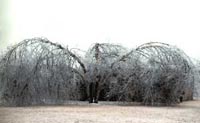Resource Library
Plant of the Week: River Birch
The University of Arkansas System Division of Agriculture does not promote, support or recommend plants featured in "Plant of the Week." Please consult your local Extension office for plants suitable for your region.
Plant of the Week
River Birch
Latin: Betula nigra

Ice storm! Those words will invariably make those of us who lost power during the Christmas storm of 2000 flinch when we hear them. The short three days my wife and I were without power were a minor inconvenience compared to what the thousands who went cold turkey for a week or longer had to endure. Ice laden trees falling across the lines caused almost all of the outages.
This might be a good time to look at how ice can meter out such havoc. I’ll use the river birch is used as an example of how trees interact with ice. The river birch probably contributed relatively little to the power losses around the state because it’s a short stature tree that grows about 40-50 feet tall. It’s also relatively uncommon along utility rights of way because it’s primarily found in more moist, lowland areas in the wild. But ice does tear it asunder and it will serve well for our discussion.
Ice accumulates on plants according to their available surface area. Plants such as loblolly pines and southern magnolias have a tremendous surface area because they’re evergreen. A leaf from my southern magnolia encrusted with a trifling quarter-inch of ice yielded 2 ounces of water when the ice melted. This 2 ounces came from a leaf with an upper surface leaf area of about 8 square inches. With a quarter inch of ice, it would take eight leaves to make a pound of ice.
But in hard hit areas where ice was reported to be up to 1 inch thick, two such leaves could accumulate up to a pound.
Deciduous trees also accumulate ice, but in their case it's their relative twigginess that gets them in trouble. Trees such as river birch that are freely branched near the crown still have a lot of surface area for accumulating ice. One foot of bare branch off of my river birch contained 1 ounce of water -- again with an ice accumulation of one-quarter inch. A river birch must contain thousands of linear feet of branches, so it would accumulate a tremendous load of ice.
The next thing to consider is the suppleness of the wood. Trees such as river birch and pine are relatively supple and will bend a great distance before they break. But there is always a breaking point.
Some relatively weak-wooded, brittle trees show little ice damage because they’re not twiggy. For example, Tree of Heaven and Cottonwood, two notoriously weak-wooded species, usually fare quite well during ice storms because they have stout, non-twiggy branches with relatively little surface area per tree.
The branching characteristic of a tree also affects its ability to tolerate an ice load. If the tree is prone to producing lots of narrow-angled branches, it will be more prone to breakage. Trees such as silver and red maple have a plethora of branches, many of which arise at acute angles with adjacent branches. As ice accumulates on the ends of the branches, the principle of the lever we learned about in high school takes hold and the weakest branches break out at these narrow crotch angles.
Oaks are more tolerant of ice damage than most trees because they have high tensile strength wood capable of holding heavy loads. Also, they usually have wide crotch angles and are mid-range in twigginess. Pines, on the other hand, have weaker wood but with much more surface area to accumulate an ice load, which is more likely to cause problems where ice is concerned.
River birch is more like a pine than an oak and usually gets hammered pretty hard when ice accumulates.
Homeowners faced with tree repair after an ice storm should not be in a rush. Unless trees pose an immediate danger, delaying pruning for a month or two will have no effect on the health of the tree. Be wary of "you gotta do it now" sales pitches from roving bands of tree pruners bent upon a vegetative chain-saw massacre.
Critically access the value of each tree after the ice storm. If the tree is so bereft of ornamental value, and it will likely never recover, go ahead and take it out. If you decide the tree is salvageable, prune out the injured branches. Try to leave the smallest wound at the cut without leaving a stub.
Check with your local Cooperative Extension office for information on tree pruning technique.
By: Gerald Klingaman, retired
Extension Horticulturist - Ornamentals
Extension News - January 5, 2001
The University of Arkansas System Division of Agriculture does not maintain lists of retail outlets where these plants can be purchased. Please check your local nursery or other retail outlets to ask about the availability of these plants for your growing area.